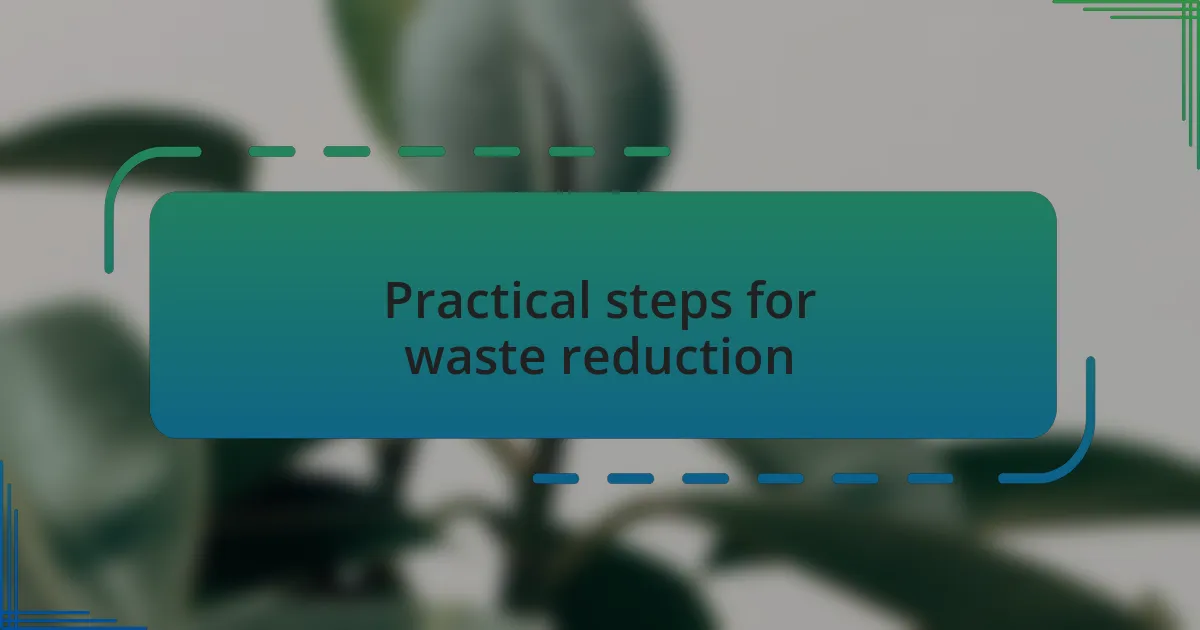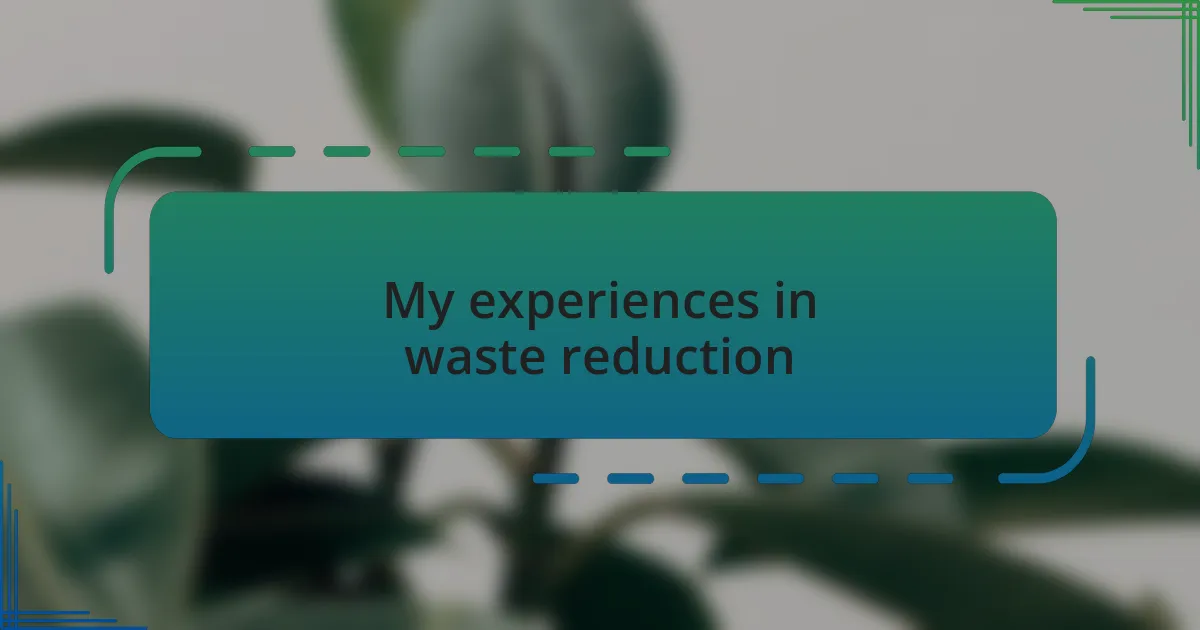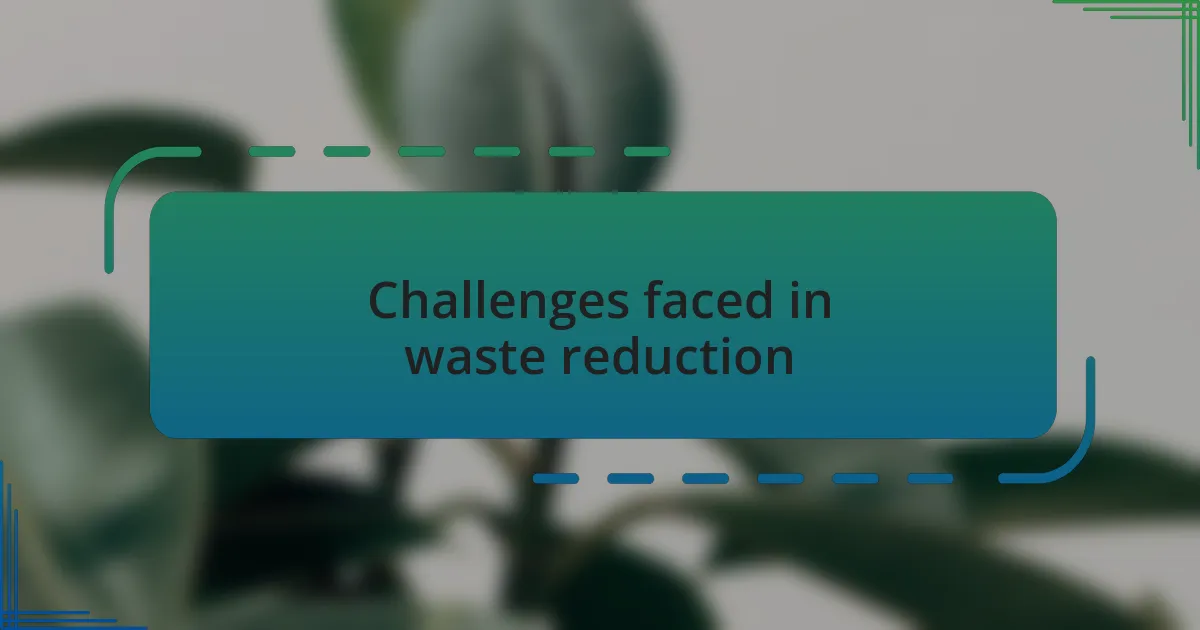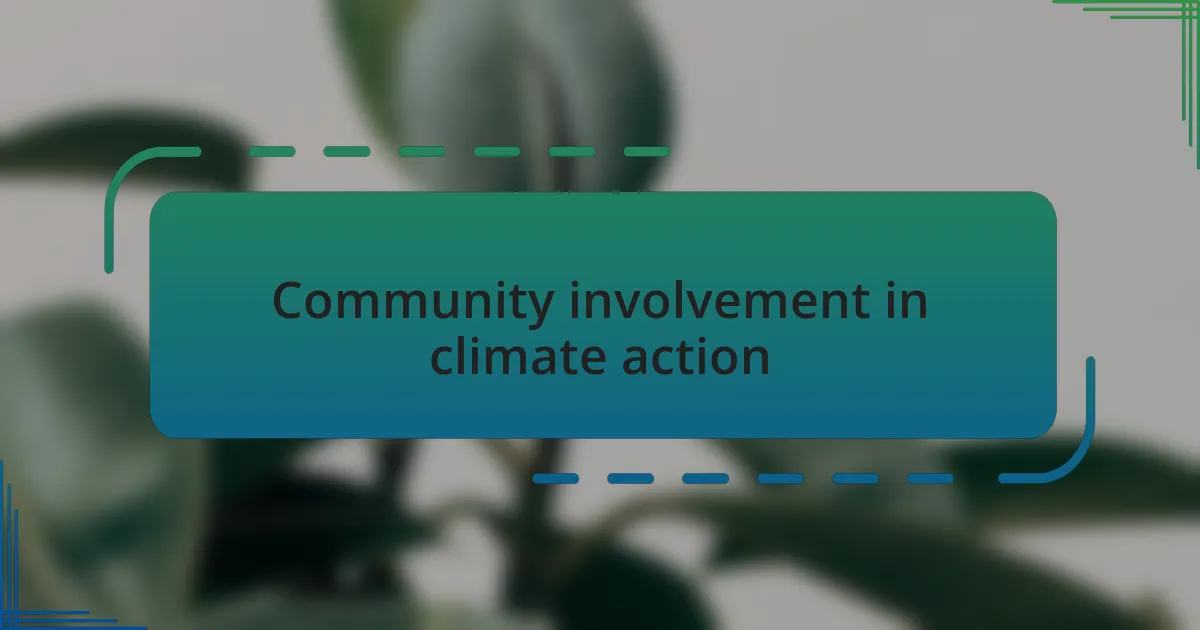Key takeaways:
- Waste significantly contributes to climate change, particularly through methane emissions from landfills, prompting a personal commitment to reduce waste within the community.
- Engaging with community members about waste reduction reveals a lack of awareness and the potential for collective action through small changes.
- Practical steps like composting, using reusable items, and supporting local sustainable businesses foster community ties and encourage environmental responsibility.
- Challenges such as convenience in adopting new habits and ineffective recycling programs highlight the need for clearer communication and stronger community engagement in waste reduction efforts.

Climate change and community waste
Waste contributes significantly to climate change, and it’s a reality that struck me hard when I first learned how much methane—a potent greenhouse gas—is emitted from decomposing organic material in landfills. I remember walking through my local park one afternoon, shocked to see litter scattered everywhere. It struck me: what are we doing to our environment? That moment sparked my commitment to reducing waste in our community.
When I started to truly grasp the impact of our waste on climate change, it became clear to me that our approach to consumption needed a serious overhaul. For instance, reflecting on my own habits, I used to see single-use plastics as convenient. But now, I can’t help but wonder: How convenient is it really if it’s destroying our planet? This realization led me to adopt more sustainable practices, and I felt a sense of empowerment as I began sharing these changes within my community.
It’s also incredibly disheartening to realize that many people remain unaware of the connection between waste and climate change. During a neighborhood cleanup event, I engaged with neighbors who had never considered recycling beyond their weekly bin. This opened up discussions about our shared responsibility in combating climate change, reminding me that while the problem feels vast, even small, collective actions can lead to significant impact. How can we inspire more people to consider their waste footprint? That’s a question I’ll keep exploring as we continue this journey.

Importance of reducing waste
Reducing waste is essential not only for environmental health but also for nurturing a sense of community. I recall a vibrant local workshop where residents shared their eco-friendly practices—each story highlighted how small changes added up to a collective movement. It made me ponder: when we reduce waste, are we not also strengthening our ties with one another?
One striking fact that continues to resonate with me is that the average person generates about 4.5 pounds of waste daily in the U.S. Reflecting on my own weekly grocery trips, I used to fill my cart without a second thought. Now, I actively seek products with minimal packaging, and I’ve noticed how it often sparks conversations with others in the store. Aren’t grocery choices an opportunity to educate and inspire each other?
Moreover, the impact of our waste reduction journey extends beyond our immediate environment. When we support local businesses that prioritize sustainability, we contribute to an economy that values the planet. I vividly recall the pride I felt attending a community fair showcasing zero-waste vendors; seeing our town embrace this shift filled me with hope. Isn’t it reassuring to know that our actions can drive positive change in our whole community?

Practical steps for waste reduction
Embracing the habit of composting has been a game changer in my waste reduction journey. When I started separating my food scraps and yard waste, I was amazed to see how quickly those materials transformed into nutrient-rich soil. Have you ever thought about how a simple household practice can contribute to healthier gardens and reduced landfill waste?
Another practical approach I’ve integrated into my routine is the use of reusable bags, containers, and utensils. Initially, I struggled to remember them when running out, but now I pack them joyfully, feeling like I’m doing my part for the planet. It’s comforting to think that every time I reach for my reusable items, I’m not just saving resources—I’m also inspiring others around me to rethink their habits. Who thought a bag could spark such conversations?
Moreover, frequenting local farmers’ markets has become a delightful tradition in my life. The vibrant array of fresh produce not only reduces the need for plastic packaging but also fosters relationships with the incredible people behind the food. Every visit reminds me that reducing waste isn’t just an individual effort; it’s a community experience that brings us closer together. Have you found ways to connect with local growers in your area?

My experiences in waste reduction
Over time, I’ve realized the importance of educating myself and my friends about the significance of waste reduction. At a recent gathering, I shared my journey, and to my surprise, several of my friends expressed interest in adopting similar practices. Can you remember a moment when sharing your experiences led to a ripple effect in your community?
Another eye-opening experience was when I decided to tackle my personal single-use plastic consumption. One day, I took a hard look at my shopping habits and recognized the abundance of plastic packaging I was bringing home. It was uncomfortable at first, but replacing plastic-wrapped products with bulk options not only lessened my waste but also opened my eyes to a myriad of new local stores and options.
I’ve also confronted my own consumer habits when it comes to clothing. I organized a clothing swap with friends, which was both a practical solution to excess garments and a fun social event. Watching my friends excitedly try on different pieces reminded me that waste reduction can be joyful and celebratory, not just a chore. Have you ever found a second life for something you once thought was out of fashion?

Challenges faced in waste reduction
Adopting waste reduction practices hasn’t been without its hurdles. One challenge that stands out is the convenience factor. I remember switching to cloth bags for grocery shopping, only to find myself in the store, regrettably empty-handed and facing the temptation of plastic bags. It made me realize how ingrained these habits are—how can we challenge ourselves to break them?
Another significant challenge is accessing recycling programs that work effectively in my community. There have been moments when I stood at my recycling bin, confused about what materials were actually recyclable. I can’t help but ask, why isn’t there clearer communication around this? My frustration often leads me to wonder if this lack of clarity deters others from practicing proper waste reduction as well.
Moreover, rallying community support can be daunting. I once tried organizing a local clean-up event, and only a handful of people showed up. It made me reflect on how easily people’s busy lives overshadow collective action. How do we inspire a sense of responsibility and commitment in others? I continually seek ways to share the benefits of waste reduction, hoping that enthusiasm can ignite action in our neighbors.

Community involvement in climate action
When I think about community involvement in climate action, I recall the surprising impact of a neighborhood meeting I attended. It was inspiring to see individuals come together, sharing their experiences and ideas on reducing waste. Have you ever felt that energy in a room when everyone is aligned toward a common goal? It reminded me that even small, localized efforts can create a ripple effect in raising awareness and inspiring others to take action.
One memorable initiative that my community launched was a monthly swap day, where everyone brought items they no longer needed. The joy on people’s faces as they exchanged books, clothes, and household items was infectious. Witnessing this spirit of sharing made me realize that not only does it reduce waste, but it also fosters connections among neighbors. How can we cultivate these opportunities for community bonding while addressing environmental issues?
On the flip side, I’ve also encountered moments of disappointment when I put forth ideas that didn’t gain traction. There was this one time I proposed starting a community garden, believing it could serve as both a hub for education and a source of fresh produce. Unfortunately, the low turnout at our initial planning meeting was disheartening. It left me pondering: what drives engagement? I’ve learned it’s crucial to address people’s interests and needs to inspire meaningful involvement.